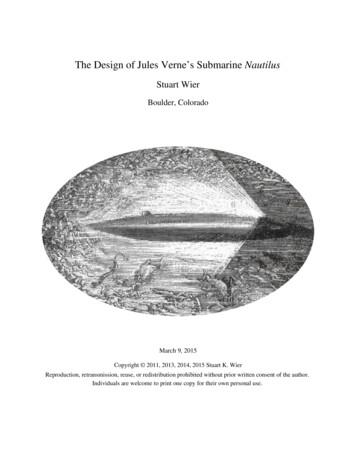
Transcription
The Design of Jules Verne’s Submarine NautilusStuart WierBoulder, ColoradoMarch 9, 2015Copyright 2011, 2013, 2014, 2015 Stuart K. WierReproduction, retransmission, reuse, or redistribution prohibited without prior written consent of the author.Individuals are welcome to print one copy for their own personal use.
AbstractJules Verne's submarine Nautilus, from his novel Twenty Thousand Leagues Under the Seas, was described byVerne in ways both detailed and consistent. Verne clearly had a particular design in mind, with exactly specifieddimensions, external shape, and internal compartments. Using dimensions given throughout the novel, supported bythe original illustrations, Verne's design can be drawn as plans, unambiguously, with no significant unresolvedquestions. His submarine description is detailed enough to permit judgments to be passed about the design's suitabilityfor a real ship. The submarine could be built as he described – under the limitation that the batteries and engine hedescribed did not yet exist. Verne's design incorporates important features used by actual submarine builders of hisday, as well as some of the newest developments in naval architecture of his time.The close fit of the Nautilus's hull shape to its interior layout, and how all the compartments fit together, stronglysuggests that Verne created actual drawings to guide his thinking and descriptions. It is unlikely that the variousnumerical dimensions of the Nautilus, internal and external, carefully given by Verne, would happen to agree bychance if his creation were simply a mental concept, or entirely verbal, written with no reference to a scaled drawingsor to measurements. Verne's submarine Nautilus is much more than a fantasy of a novelist's imagination.A plan (horizontal cross section) and elevations of Verne's design are presented. The hull, 70 meters long, is purelycylindrical throughout much of its length, with a circular cross section of 8 meters. The bow and stern are simplecones, thence tapering into the cylinder. A platform or deck on top only 0.8 meters above the waterline features apilot house, a recess for the ship's boat, one hatch to the interior, and a strong light for underwater illumination on apedestal about 1.5 meters high. There is a single propeller of four blades and 6 meter diameter, and a rudder mountedon a sternpost. There is one pair of diving planes, mounted at midsection of the hull. Most of the major interiorcompartments are described in detail with their dimensions and furnishings. The salon has a large oval port on bothsides of the hull for underwater viewing. An airlock with a door allow helmet divers to step directly onto the sea floor.IntroductionIn 1867 when Jules Verne was beginning to plan a novel about an undersea voyage, he and his brother Paul traveledto the United States on board the Great Eastern. The Great Eastern was an enormous vessel for its time, 213 meters(698 feet) long and 23 meters (75 feet) wide, the largest vessel afloat, and it incorporated some of the newest featuresof marine architecture. It had a double iron hull, sails, steam engines, paddle wheels, and a propeller 7.3 meters (24feet) in diameter. Verne showed and described his keen interest in the ship, and noted details of its design,construction, and operation. Thinking of a visionary undersea vessel, he found himself traveling on the most advancedship of his time. In the United States Verne saw other new technology, such as the large and fast Hudson Riversteamboats. This was a period of delight in rapid technical progress.For the past century the submarine has played an important role in naval affairs, and in the past 50 years submersibleshave become valuable in the scientific exploration of the oceans. Yet a fictional submarine, conceived decades beforereal submarines took up sea going duties, remains a candidate for the most renowned: Jules Verne's Nautilus, from hisnovel Twenty Thousand Leagues Under the Seas.Jules Verne is rightly regarded as a prophet of many of the inventions which characterized twentieth century life. Thenovels of Jules Verne are as well known for their technical innovations as for their journeys and exotic locations. Thesubmarine Nautilus and its enigmatic captain Nemo are among Verne's most famous creations. Even some who havenot read Verne know that the Nautilus foreshadowed large modern submarines.
The Great Eastern.Verne's success in foreseeing the large size and sea keeping capabilities of actual submarines has long beenrecognized. Submarine design gradually approached, over decades, the fictional size, shape, and performance ofVerne's Nautilus. Only near 1960 did submarines begin to equal the performance of the fictional Nautilus, 90 yearsafter Twenty Thousand Leagues Under the Seas was published. Less appreciated is the technical merit of Verne'ssubmarine design, a concept so detailed that it could be used to build a submarine, one with faults but no worse thansubmarines made by engineers of his day, and in many ways correctly indicating future developments. Joiningtechnology of his day, principles of science, and some assumptions about what might be possible in the future with hiscreativity, Verne came surprisingly close to some aspects of modern submarines.In the late 1860s when Verne wrote Twenty Thousand Leagues Under the Seas, much of the technology we take forgranted was unknown or poorly known. Electric lights were experimental, and batteries and electrical motors weresmall, primitive, and inefficient. The relations between voltage, current, and power were not clear. The very conceptof energy as a measurable quantity was little understood. Few practical electrical devices were in use, yet Verne sensedgreat possibilities in electricity. He was right in foreseeing large powerful electrical motors; he was wrong in hopingfor large batteries supplying enormous power for days or weeks without recharge.The original illustrations from the 1871 edition are a useful aid in support and interpretation of Verne's writing. Infact the illustration of the submarine from the original edition, copied on the title page of this report, is a completelycorrect indication of the shape of the hull. Though the illustrations do not always confirm Verne's descriptions, and insome cases are inconsistent even among themselves, they often verify or elaborate details in the novel. The twoillustrators, Edouard Riou and Alphonse Marie de Neuville, brought in by Verne's publisher Pierre Hetzel, wereobviously familiar with the novel and used it as a guide for their creations.“All these illustrators were collaborators and friends of Jules Verne. They met together at the same Parisiancafes; they discussed their projects and formed a team united, interdependent, and very enthusiastic.”(A. Gernoux, Les Annales de Nantes, 10 April 1955, quoted in Edmondo Marcucci, "Les Illustrations desVoyages Extraordinaire de Jules Verne"; Paris: Bulletin Societe Jules Verne 1956, p. 17.)
One of de Neuville's illustrations shows Nemo looking at plans of the Nautilus. Did Verne (or someone he knew)draw plans of Verne's conception of the Nautilus? Did he share the plans with his illustrators? I believe so, given theinternal consistency of the measurements he gives of the Nautilus, how well it all fits together.This is not an attempt to detail Verne's process of creation of the Nautilus, nor an exhaustive analysis of the Nautilusas a submarine. The intention is to present a complete plan with all the details and interior arrangements of Verne'sNautilus, as described in Verne's original French text, aided by the illustrations from the 1871 edition. Figure 1 showsmy plan for the Nautilus, which is consistent with Verne's descriptions and which attempts to include all his details anddimensions, and also be in agreement with the original illustrations so far as is possible. Figures 2 through 4 arephotographs of a 1:100 scale model of the same design. Figure 5 is an artistic impression of the plan in Figure 1. Thiswas made by modifying a modern submarine picture found online (blogs.knoxnews.com/eder/2007/12/new submarinemoney has nuke f.html, published in 2007). I have not been able to find the creator (or the original image) of thispicture.This report expands on an article I prepared in 1982. I had long been interested in Verne’s submarine, and had justdiscovered new translations of his novel Twenty Thousand Leagues Under the Seas which included Verne’s technicaldetails. The previous translation into English was so poor that Verne’s submarine description was garbled beyondcomprehension. In fact, even then, more than 110 years after the novel appeared, there was little or no realization inthe U.S. that Verne actually had described a vessel which could be drawn on paper and evaluated in technical terms.Reading a new translation by Mendor T. Brunetti (Signet Classics, 1969), and assisted by Walter James Miller’sannotated edition of the old translation (New American Library 1976), I realized then that Verne had outlined a truedesign for a submarine, and one which was, in the terms of his time, a remarkably plausible projection of what might bepossible. I read the translations and began to recreate Verne's plan from information in the novel, excited to see whatVerne described in detail. For my own understanding of Verne's technical details, I turned to his words. I took care totranslate Verne's descriptions as precisely as possible, in terms of their technical context, including nauticalterminology.Finding interest in the Nautilus online in 2011, I expanded my original report from 1982 and made it available onmy web site. Since 2011 I have found that enthusiasts of Twenty Thousand Leagues Under the Seas independentlycreated other plans of the Nautilus.An early investigation similar to mine is that of Jean Gagneux, Chief Engineer on the French nuclear submarineRedoutable, who made a detailed and complete study of Verne's Nautilus in 1980, before my original work, but which Ihave only recently discovered. His findings are close to mine.March 9, 2015Boulder, Colorado
Figure 2
Figure 3Figure 4
Figure 5. Artist's impression of the submarine Nautilus of Jules Verne. Copyright (c) 2015 Stuart K Wier
“The Enormous Iron Cylinder:” The Hull of the NautilusJules Verne's Nautilus is an "enormous cylinder of sheet iron,” l'énorme cylindre de tôle. Is is a streamlined,tapering at each end, and mostly free of angular protrusions. The Nautilus is quite a large ship, 70 meters (230feet) long and 8 meters (26.2 feet) wide. Unlike modern naval submarines the interior includes large elegantrooms furnished with fine art, museum quality artifacts, furniture, and carpets.Captain Nemo describes the Nautilus as an elongated cylinder with conical points, and says it has “a formalmost like a cigar.” Note the diagram in the illustration above. Later in the novel, Professor Aronnax states thebow and stern of the Nautilus are “fusiform,” spindle shaped, and the hull can justly be compared to a long cigar.Nemo's initial description might apply to a cylinder of uniform diameter with two conical end caps. However,such a shape is not exactly spindle shaped, or cigar like. Nemo elaborates, saying “its lines are sufficiently longand its streamlines prolonged enough, that displaced water moves aside easily and opposes no obstacle to itsprogress.” The illustrations usually show a hull shape with long gradual curves.Can we reconcile these statements, the cylinder with conical ends, and the streamlined spindle? Yes, and it iseasy to do so. A central cylindrical section of the hull with uniform diameter can be smoothly joined to true conesat the ends. This is a cylinder to cone transition junction. The curve of the hull there in a longitudinal cross section is an arc of a circle, and a circle can be found which is tangent to any combination of central cylinder andan end cone of any length, with no bulge or change in slope at either contact. In other words, the hull outline is
smooth. Appendix A shows some combinations of conical end sections and circular arcs, some various possibledimensions for the cylinder to cone transition junction, which smoothly join the cones to a central cylinder of 8meters diameter.The original illustrations frequently show a hull with a curved shape fore and aft; none have purely conical ends,which would appear with a profile outline showing only straight lines. However there are illustrations showingthe hull in profile with two different lengths of the curved hull sections, at odds with each other: one has longtapers or sharper ends and the other has more blunt ends, such as the next picture, a detail from an originalillustration showing the Nautilus passing a sinking ship. The illustration on the title page of this report is the morecigar like form. Either of these is consistent with the hull description, but not always with interior details.My plan and model of the Nautilus (Figures 1 4) agrees with all of Verne's measurements and descriptions.This hull shape and size encloses the interior compartments of the Nautilus described by Verne. The hull inFigure 1 is purely cylindrical in its central 30 meters (98.4 feet) of length, with a diameter of 8 meters (26.2 feet).This is the minimum length of any 8 meter cylinder which can contain the forward end of the salon in the doublehull. The salon and double hull are described in detail below. Any shorter centrally positioned 8 meter diametercylinder cannot fit the salon inside. Since it is circular in cross section the maximum beam (width) is 8 metersand the distance from the top deck to the bottom of the hull is 8 meters.Five meters (16.4 feet) at each end of the hull (Figure 1) are true cones, each with a base diameter of 3.24 meters(10.6 feet). Joining the central cylinder to the end cones are two parts of the hull which are curved in profile, each15 meters long. The outer hull curve in a central longitudinal cross section is a circular arc of radius 48.5 meters(159 feet). This figure is used only in drafting; that length is not seen on the plans.This hull shape is intermediate between the most streamlined hulls and the blunt hulls in the novel's illustrations.A hull with a longer cylindrical section would also fit Verne's interior measurements, but any more streamlinedshape will not. Note that there is no reason at all that Verne's hull shape would be anything other than a regularcircular cylinder in much of the length, smoothly joining simple cones at the ends. There are no swellings,bulges, ridges, polygonal shapes, protruding rams, or saw edged fins. As much fun as those might appear,The finish of the outside of the hull also has two descriptions, again somewhat at odds with each other. WhenProfessor Aronnax first boards the Nautilus floating on the surface he says the hull “was smooth, polished, and
not imbricated,” imbricated meaning showing overlapping edges in a regular pattern. He also says it seemed to bebuilt of bolted plates. Much later he says, “these sheet metal plates, lightly imbricated, resembled the shells oflarge terrestrial reptiles.” The novel's original illustrators consistently show delineated and possibly overlappingplates with lines of bolts or rivets, typical of metal hull construction of the time. It seems Verne imagined theNautilus had a hull of smooth or polished metal plates, but also showing bolts or rivets, with lines or overlaps atthe edges of the plates. This form of hull construction survived to World War I and beyond.The hull is made of two shells, one inside the other, connected with “T irons.” Nemo calls this a “cellularconfiguration” which has “extreme rigidity” so that the hull resists pressure like a solid block. It had better – theNautilus routinely cruises at depths of thousands of meters. The shells are made of sheet steel, with a density of7.8 grams per cubic centimeter. The outer hull or shell is five centimeters thick (1.97 inches). This is similar tothe thickness of the steel pressure hulls of many modern submarines. The keel is 50 cm (20 inches) high and 25centimeters (10 inches) thick.There is no indication of the thickness of the inner shell, or of the width of the double hull. But Verne's voyageon the Great Eastern may have formed his ideas in this matter. The Great Eastern like the Nautilus had a doublehull. The drawing above is half of a transverse section of the double hull of the Great Eastern (from ScientificAmerican, Dec. 27, 1862), and we can use this design as a guide to what Verne might have regarded as a gooddesign for the hull of the Nautilus. (The chain in the drawing is not part of the hull.) The total thickness of theGreat Eastern's double hull was 0.86 meters (2 feet 10 inches). Since the Great Eastern was close to three timeslarger than the Nautilus in linear dimensions, the same hull structure scaled down to a third for the Nautilus wouldbe about 0.29 meters (11 inches) thick, an initial estimate of what Verne may have had in mind. Verne's Nautilusalso has watertight transverse bulkheads for safety, another new idea he may have copied from the GreatEastern.More recent actual submarines often had or have double hulls as well. But whereas Verne's double hull madeup one pressure resisting hull, actual submarines have a pressure hull on the inside while the outer hull is notpressure resisting, allowing full pressure seawater inside, to provide streamlining and covering for machineryoutside the pressure hull which can be exposed to sea water pressure. Modern outer hulls may be about 2 cm
thick (1 inch) and the inner pressure hull about about 5 cm thick (2 inches) based on published data for th eRussian submarine Kursk. The Kursk had a 2 meter separation between the outer and inner hulls.The maximum depth reached by the Nautilus in Verne's novel is 16,000 meters (52,480 feet or close to 10miles), in Part 2, Chapter 11, subjecting the hull to a pressure of 1600 atmospheres or 10 metric tons per squareinch (1.6 metric tons per square centimeter). This depth far exceeds the depth capability of any large submarine,and exceeds the deepest part of the ocean, now known to be about 10,900 meters.The bow of the Nautilus is used as a ram to damage or sink ships. Describing the construction of the submarine,Nemo mentions the ram as special forging, saying it was made in Motola, Sweden. Iron and steel forgings arestill made in Motala. It appears that Verne imagined the ram as a single steel casting several meters long, whichmade up all or part of the forward conical section of the hull. There is no mention of a protruding ram or harpoon.In the early part of the novel, Aronnax mentions a Cunard steamship, the Scotia, which collided accidentallywith the Nautilus, suffering a hole like an isosceles triangle 2 meters across, as if made by a cutting machine. Sothe point seems to be be cut or tapered to make three edges, modifying its basic conical shape. Incidentially theScotia was a real steamship of Verne's time, which carried Theodore Roosevelt and his family to Europe in thesame year in which it supposedly was struck by the Nautilus, but without encountering submerged obstacles.Such details exemplify how Verne used actual circumstances of his time to provide a basis in reality.One measure of the size of a submarine is its displacement. Displacement of a submarine is measured by thevolume of water it occupies, typically when fully submerged, or by the weight of seawater in that volume. Onecubic meter of pure water weighs exactly one metric ton, 1000 kilograms (2205 pounds), and by chance is alsoclose to one English “long” ton (2240 pounds, 20 times the antique weight unit “hundredweight”). So whendealing with pure water a cubic meter of water (a volume) is also one metric ton (a weight). Verne uses thisequivalence.Nemo says the Nautilus displaces “1500.2 cubic meters, which means when entirely submerged it displaces orweighs 1500 cubic meters or tons.” Verne made two errors here. A cubic meter of fresh water weighs a metricton, but a cubic meter of seawater weighs typically 1.025 times more. The Nautilus is a vessel of the oceans, notof fresh water. Only 2.5 percent more, but that is significant if you build a submarine. If your submarine is underweight by 2.5 percent, it will never submerge.A much larger error is that, despite Verne's usual precision, his stated displacement for the Nautilus is simplyimpossible. The central cylindrical section, 8 meters in diameter and 30 meters long, as in Figure 1, alone has avolume of 1507.96 cubic meters, leaving less than nothing for the other 40 meters of the hull length. It is notpossible in nay way to design a hull which fits Verne's numerous other measurements and also has 1500.2 cubicmeters volume. The design in Figure 1, which matches all of Verne's other specifications, has a submergeddisplacement very close to 2500 cubic meters (in weight of seawater, about 2562 metric tons). The similarity ofthe numbers 1500 and 2500 suggests that Verne's use of 1500.2 cubic meters in place of 2500 was a simple caseof a copying mistake somewhere along the line, with one numeral in error.This is a large submarine. Verne's Nautilus is ten times larger than any real submarine before 1900. Thecommon German Type VIIC U boat of WWII was 865 tons. US fleet submarines of World War II were mostlyabout 2400 tons. Modern fleet ballistic missle submarines are far larger than 2500 tons.Surfaced, a submarine displaces (weighs) less; water pumped out of ballast tanks is replaced with air and thelower weight of the entire vessel causes it to float and emerge above the sea surface. The top deck of the floating
Nautilus is 0.8 meters above the water level, one tenth of the top platform to keel separation of 8 meters. Nemosays, “I wished, when surfaced it would emerge only one tenth. Consequently in these conditions it must displaceno other than nine tenths of its volume.” This would be true if the Nautilus were rectangular in cross section, along square box, but being circular, less than one tenth of the volume is occupied by the top tenth (0.8 m) of the 8meter circular cross section. The design in Figure 1 reduces the displacement by 6.2 percent, 155 cubic metersout of 2500, when the deck is 0.8 meters above the water, including the pilot house, hull enlargement to form thedeck, longboat, and searchlight.These errors are simple mistakes which do not alter the novel's essential quality. They are at odds with Verne'soccasional preoccupations with much smaller technical adjustments, such as Nemo's discussion of the effects ofthe compressibility of sea water, a far smaller effect than density variations between fresh and salt water, whichVerne completely missed. But all these technical details by Verne show his desire to build on reality.There is a flat deck or platform on top of the Nautilus; the platform lies eighty centimeters (31 inches) abovethe level of the sea when the submarine is floating on the surface. Professor Aronnax says the hull itself forms, inits upper part, a sort of horizontal platform. Several illustrations show the riveted plates of the pressure hullforming the flat surface. Later practical submarines had upper decks made of gratings of metal or wood attachedto pressure hulls maintaining circular cross sections throughout. A removable railing can be installed around thedeck.
“An Excellent Craft”: The Nautilus' LongboatThere is a longboat, “light and unsinkable,” for excursions and fishing. The boat is stored in the middle of thedeck, half sunk in a recess in the ship's hull, forming a bulge of some kind above the deck. On one occasionAronnax said he was seated on the protrusion made by the hull of the boat. Several of the original illustrations (asnext) show a bulge on the hull which is either the boat, or a cover over the boat. The boat can hold at least tenpersons: six oarsmen, one at the tiller, and three passengers in the stern. A length more than 5 meters (16 feet) iscalled for. Despite this size, Aronnax says two men can remove the boat from its recess and launch it in the sea.One illustration (shown below) shows a large boat sitting upright behind a large coil of rope, and it appears to bea typical wooden lapstrake or clinker built boat of Verne's time. The entire illustration appears to have beeninspired by fishermen on a beach, not by the Nautilus. Nemo describes his boat as having unique features,nothing like those of a wooden boat. His boat is“.entirely decked over, absolutely watertight, and held in place by solid bolts. This ladder leads to a hatch inthe hull of the Nautilus, which corresponds to similar hatch pierced in the side of the boat. This double openingadmits me to the boat. Someone closes the hatch of the Nautilus, and I close the other in the boat, by force ofpressure. I release the bolts and the boat rises with tremendous speed to the surface of the sea. Then I open thepanel of the deck, carefully closed until then, I step the mast, I raise sail or take my oars, and go on my way.”This indicates that the boat's compartment does not have a separate cover – if Verne described the submergedlaunching of the boat completely. Verne fails to suggest how a boat large enough to hold ten men, covered tohave a watertight interior, and strong enough to resist the depths reached by the Nautilus, can be light enough fortwo men to remove fromits position 'half sunk' in arecess in the hull. The boatof the Nautilus, and itsoperation as described, isfascinating, but scarcelypractical.
“All the forward part of the submarine”:Interior Layout and FurnishingsThe dining room.Entry to the interior of the Nautilus is by a staircase from the top deck, closed on top by a panel, and endingbelow near the center of the submarine. This stair could be quite steep, as is often the case on ships, such as thestairs shown in the illustration of the engines of the Great Eastern in the the final part of this report, stairs whichVerne himself may have climbed. Verne terms the central stair a “ladder” three times; the steepness of such amarine stair easily explains the use of that word. French – like English – needs a special word for steep marinestairs.The interior of the Nautilus includes several large ornamental compartments. Aronnax gives the exactdimensions. Going forward from the center of the ship to the bow there is a dining room 5 meters (16.4 feet)square, then double doors leading to a library of the same size. Forward of the library is the grand salon,
rectangular, 10 meters (32.8 feet) long, 6 meters (19.7 feet) wide, and 5 meters (16.4 feet) high. The salonoccupies the full width of the hull but the dining room and library do not.The dining room has tall oaken sideboards at both sides of the room, and sparkling on their shelves are rows offaïence, porcelain, and glass of incalculable value. Silver plated dinner service shines under rays of light pouringfrom fixtures in the ceiling.The library.This illustration depicts the library of the Nautilus exactly as Verne describes it. There are dark bookcases,ornamented with copper, lining the walls, large divans upholstered in maroon leather, and a central table. Adouble door in the aft partition, not shown, leads through a watertight bulkhead into the dining room. Anotherdoor forward leads to the salon. The light, movable reading stands or supports for books are a nice period touch,as mentioned in the novel. The library holds 12,000 volumes. Illumination is by four frosted electric half globesin volutes of the overhead or ceiling.
The SalonThe salon is splendid. Its furnishings account for more than half the cost of the Nautilus. Thirty paintings bygreat masters cover the walls, from the Renaissance to 19 th century France, but no impressionists, of course.Small copies of marble and bronze statues from antiquity stand in corners. There is an organ and music for it; theearliest composer is Mozart and the most recent Wagner. Nemo has no Bach fugues to perform on the organ.There is a trained naturalist's collection of wonderful marine specimens, and a fountain, of all things, which fallsinto the shell of a tridacna clam some 6 meters (20 feet) around, or about 2 meters (6 feet) across, anextraordinary shell in its own right.The salon has “cut corners,” as shown in the illustration above. Aronnax says “doors pierce each cut corner ofthe salon.” Indeed there are four doors in each corner of the salon: one from the library (aft), one from Nemo'scabin forward, one leading to a passage going aft, and one leading to a short passage going forward, alongsideNemo's cabin, to the cabin used by Aronnax. The illustration shows two of those four doors, in the cut corners.
The salon as illustrated looks like the drawing room of a Scottish baronial residence of the Victorian period, evento the trophies of arms on each side wall. The proportions of this drawing are a little wrong; the salon is widerthan tall.A Window of the NautilusDespite what is in effect a world class collection of art and artifacts, the most memorable feature of the salon arethe windows which allow the passengers of the Nautilus to gaze upon the living marvels of the sea. There are twowindows, one on each side of the salon. The original illustrators depicted a salon window three times, always asan oval about 2 meters high by 3 meters long (about 6 by 10 feet). Verne does not indicate any size, and onlysays they are “oblong openings.” Metal panels, operated by unseen machinery, can cover the windows. Oddlythe first illustration of the salon shows no windows which are dramatically illustrated elsewhere.Forward of the salon is Nemo's cabin, 5 meters (16.4 feet) fore and aft, and then an “elegant chamber” used byAronnax 2.5 meters (8.2 feet) fore and aft. The widths are not given. Nemo's cabin is severely plain. Forward of
Aronnax' cabin, the hull extends
"The Enormous Iron Cylinder:" The Hull of the Nautilus Jules Verne's Nautilus is an "enormous cylinder of sheet iron," l'énorme cylindre de tôle. Is is a streamlined, tapering at each end, and mostly free of angular protrusions.










